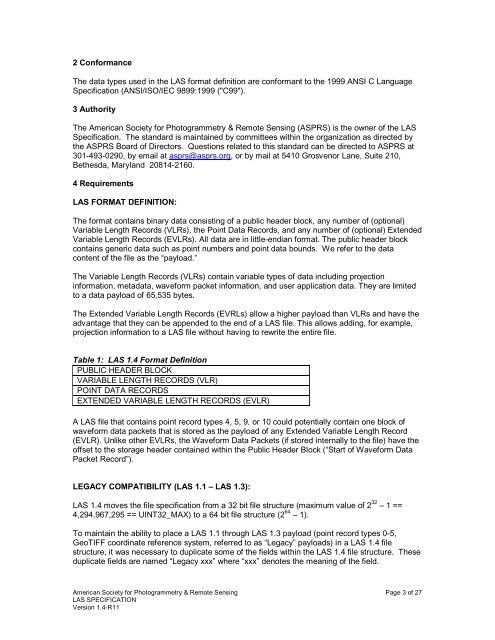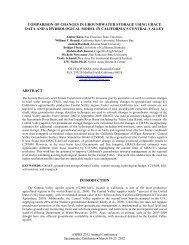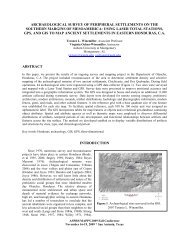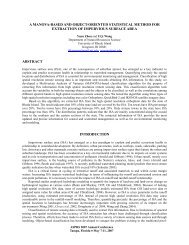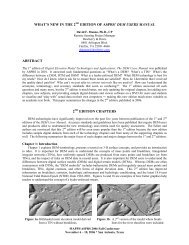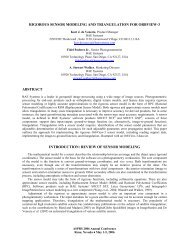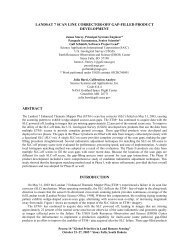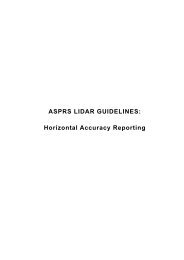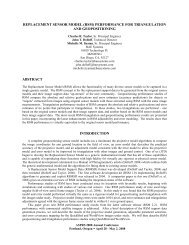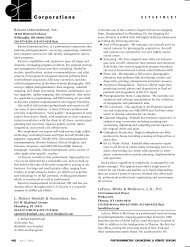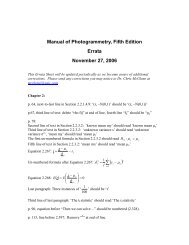LAS SPECIFICATION VERSION 1.4 – R11 - asprs
LAS SPECIFICATION VERSION 1.4 – R11 - asprs
LAS SPECIFICATION VERSION 1.4 – R11 - asprs
Create successful ePaper yourself
Turn your PDF publications into a flip-book with our unique Google optimized e-Paper software.
2 Conformance<br />
The data types used in the <strong>LAS</strong> format definition are conformant to the 1999 ANSI C Language<br />
Specification (ANSI/ISO/IEC 9899:1999 ("C99").<br />
3 Authority<br />
The American Society for Photogrammetry & Remote Sensing (ASPRS) is the owner of the <strong>LAS</strong><br />
Specification. The standard is maintained by committees within the organization as directed by<br />
the ASPRS Board of Directors. Questions related to this standard can be directed to ASPRS at<br />
301-493-0290, by email at <strong>asprs</strong>@<strong>asprs</strong>.org, or by mail at 5410 Grosvenor Lane, Suite 210,<br />
Bethesda, Maryland 20814-2160.<br />
4 Requirements<br />
<strong>LAS</strong> FORMAT DEFINITION:<br />
The format contains binary data consisting of a public header block, any number of (optional)<br />
Variable Length Records (VLRs), the Point Data Records, and any number of (optional) Extended<br />
Variable Length Records (EVLRs). All data are in little-endian format. The public header block<br />
contains generic data such as point numbers and point data bounds. We refer to the data<br />
content of the file as the “payload.”<br />
The Variable Length Records (VLRs) contain variable types of data including projection<br />
information, metadata, waveform packet information, and user application data. They are limited<br />
to a data payload of 65,535 bytes.<br />
The Extended Variable Length Records (EVRLs) allow a higher payload than VLRs and have the<br />
advantage that they can be appended to the end of a <strong>LAS</strong> file. This allows adding, for example,<br />
projection information to a <strong>LAS</strong> file without having to rewrite the entire file.<br />
Table 1: <strong>LAS</strong> <strong>1.4</strong> Format Definition<br />
PUBLIC HEADER BLOCK<br />
VARIABLE LENGTH RECORDS (VLR)<br />
POINT DATA RECORDS<br />
EXTENDED VARIABLE LENGTH RECORDS (EVLR)<br />
A <strong>LAS</strong> file that contains point record types 4, 5, 9, or 10 could potentially contain one block of<br />
waveform data packets that is stored as the payload of any Extended Variable Length Record<br />
(EVLR). Unlike other EVLRs, the Waveform Data Packets (if stored internally to the file) have the<br />
offset to the storage header contained within the Public Header Block (“Start of Waveform Data<br />
Packet Record”).<br />
LEGACY COMPATIBILITY (<strong>LAS</strong> 1.1 <strong>–</strong> <strong>LAS</strong> 1.3):<br />
<strong>LAS</strong> <strong>1.4</strong> moves the file specification from a 32 bit file structure (maximum value of 2 32 <strong>–</strong> 1 ==<br />
4,294,967,295 == UINT32_MAX) to a 64 bit file structure (2 64 <strong>–</strong> 1).<br />
To maintain the ability to place a <strong>LAS</strong> 1.1 through <strong>LAS</strong> 1.3 payload (point record types 0-5,<br />
GeoTIFF coordinate reference system, referred to as “Legacy” payloads) in a <strong>LAS</strong> <strong>1.4</strong> file<br />
structure, it was necessary to duplicate some of the fields within the <strong>LAS</strong> <strong>1.4</strong> file structure. These<br />
duplicate fields are named “Legacy xxx” where “xxx” denotes the meaning of the field.<br />
American Society for Photogrammetry & Remote Sensing Page 3 of 27<br />
<strong>LAS</strong> <strong>SPECIFICATION</strong><br />
Version <strong>1.4</strong>-<strong>R11</strong>


